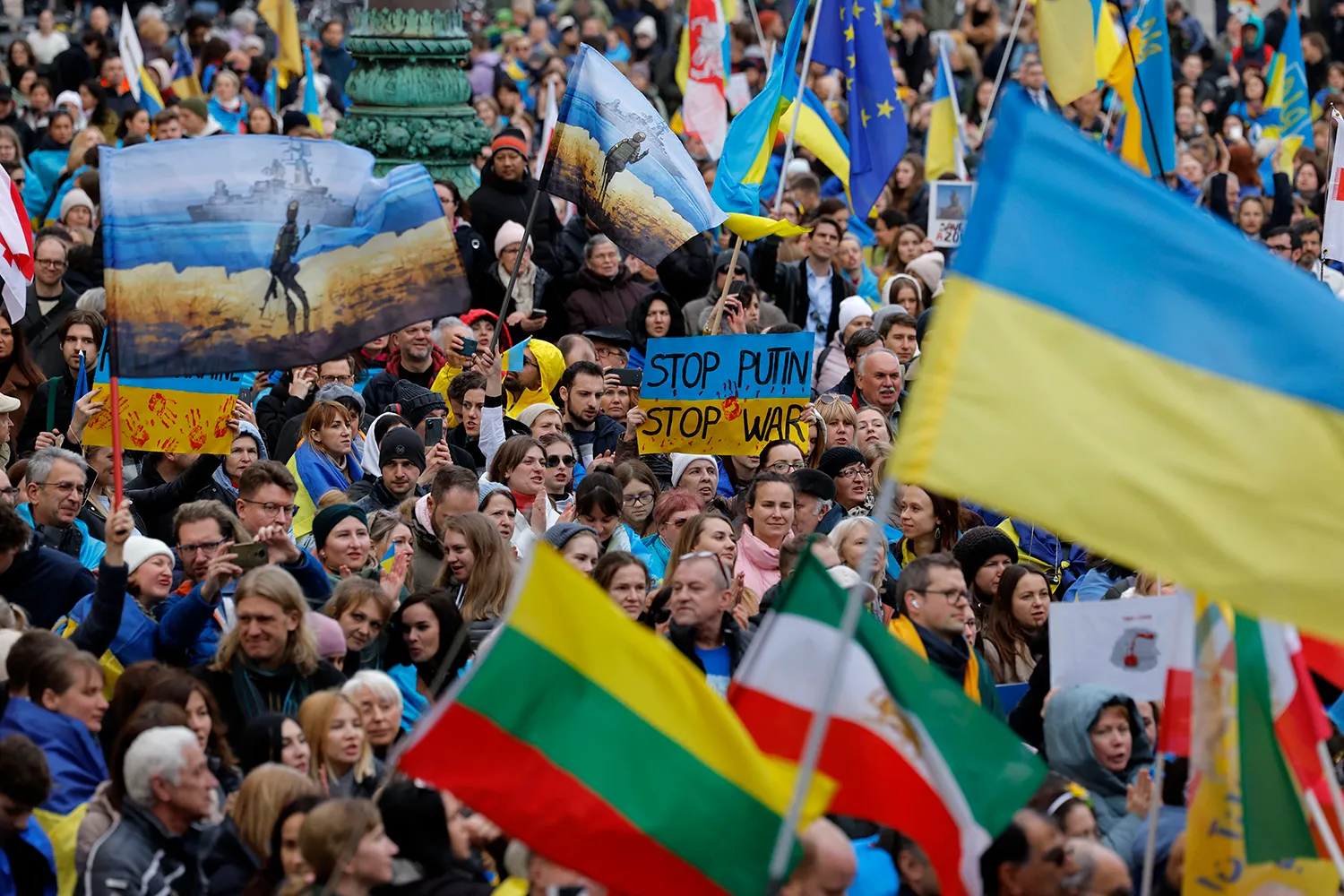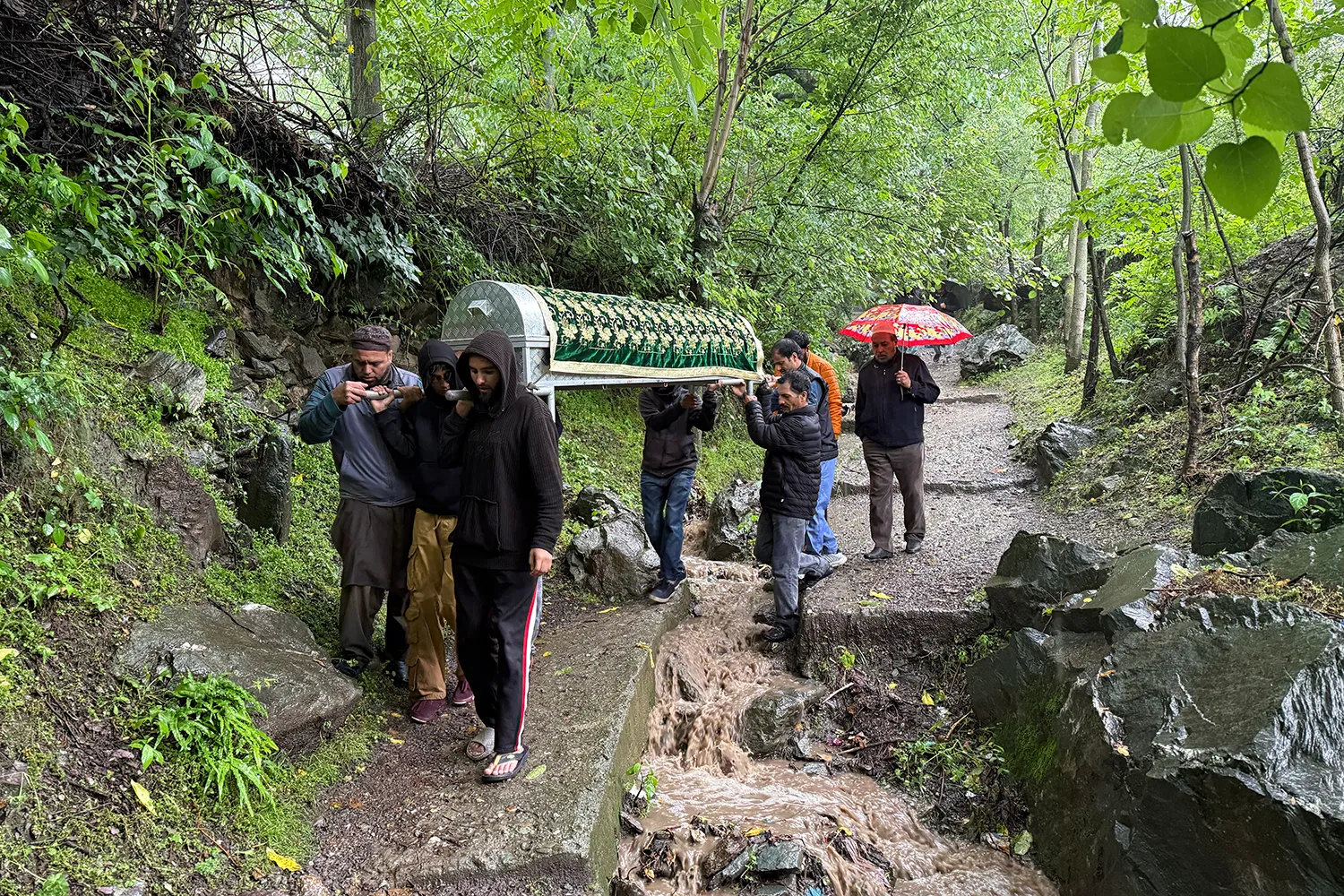What Is Russia Up To in Europe?

Demonstrators wave the flags of Ukraine, Iran, Europe, Lithuania, and others as they take part in a pro-Ukrainian rally at Odeonsplatz square on the sidelines of the Munich Security Conference in Munich on Feb. 18, 2023. ODD ANDERSEN/AFP via Getty Images
Since Russia resumed its campaign of sabotage and disruption across Europe in earnest in early 2024, there has been much speculation as to what exactly the Kremlin’s aims might be. That question has even greater urgency today. With the United States seeking to “partner” with Russia and the looming prospect of a Moscow-dictated settlement being imposed on Ukraine with U.S. assistance, Russia’s intelligence services may be free to step up their campaign of mayhem across the continent.
Some of the attacks so far have appeared confusingly random; it’s hard to see how Russia benefits from arson at an IKEA in Lithuania or a small warehouse in London. That’s led to a supposition that Moscow’s primary objective has simply been to foster a general antipathy among European populations toward their governments’ support for Ukraine by sowing fear, uncertainty, and doubt. But few of the attacks have even registered on the public consciousness of the targeted countries, so it’s difficult to see how this amounts to a serious terror campaign.
Since Russia resumed its campaign of sabotage and disruption across Europe in earnest in early 2024, there has been much speculation as to what exactly the Kremlin’s aims might be. That question has even greater urgency today. With the United States seeking to “partner” with Russia and the looming prospect of a Moscow-dictated settlement being imposed on Ukraine with U.S. assistance, Russia’s intelligence services may be free to step up their campaign of mayhem across the continent.
Some of the attacks so far have appeared confusingly random; it’s hard to see how Russia benefits from arson at an IKEA in Lithuania or a small warehouse in London. That’s led to a supposition that Moscow’s primary objective has simply been to foster a general antipathy among European populations toward their governments’ support for Ukraine by sowing fear, uncertainty, and doubt. But few of the attacks have even registered on the public consciousness of the targeted countries, so it’s difficult to see how this amounts to a serious terror campaign.
It’s only after stripping away the seemingly pointless attacks and focusing on those with an obvious objective that the pattern of Russia’s activities in Europe becomes clearer. And that pattern consists of not only actual sabotage but also reconnaissance, probing, and testing in the physical and digital domains, with a focus on communications, logistics, and emergency preparedness.
In 2020, I participated in a study by the Swedish Defence Research Agency, which listed where and how Russia might carry out covert attacks across Europe ahead of an overt military attack on a NATO member—with the aim of immobilizing the continent and rendering it unable to respond.
We’ve seen the items on that list ticked off one by one over the past year, including cyber intrusions; the activation of human assets; the jamming of GPS and other navigation systems, including for aircraft, attacks on subsea communications, and energy infrastructure; and other physical sabotage.
Everything we have seen in Europe suggests that Russia is testing the accessibility of its targets, the impact of its actions, and the reactions by the authorities in the targeted countries.
Each time Russia carries out an attack of this kind, it learns about the target country’s capacity for detecting it, mitigating the consequences, and prosecuting the offenders. All of this helps the Kremlin’s planners identify the softest targets for when they decide the time is right for a full-on campaign.
As Europe scrambles to ramp up support for Ukraine and to determine whether to send troops to support a cease-fire, Russia’s aim could be to intimidate or deter countries from doing so. And the worst-case scenario—preparation for an overt attack on a NATO member state—is still on the table. U.S. Defense Secretary Pete Hegseth’s confirmation of limited U.S. interest in defending Europe last week lent weight to earlier calls for Washington to withdraw its forces from NATO’s eastern frontier. That’s the surest way to turn the possibility of a challenge from Russia into a probability.
We must hope that Russia’s campaign of sabotage and probing is also a learning experience for the target countries, helping them be better prepared for if and when Russia turns up the heat. So far, the publicly known attacks have been individual and isolated; the impact would obviously be much greater if Russia conducted a coordinated mass campaign across multiple locations and domains. That should focus the minds of the governments and the public in Western Europe that have only now realized that they, too, are a target for Russia. Because if NATO’s defense chiefs are right that Moscow is planning military attacks beyond Ukraine, there is no part of Europe that isn’t at risk from Russian efforts to coerce or immobilize the victim and its allies.
This story is part of a collection on what’s next for Europe and Ukraine. Read the full package here.
Keir Giles is a senior consulting fellow in the Russia and Eurasia Program at Chatham House and the author, most recently, of Who Will Defend Europe? An Awakened Russia and a Sleeping Continent.
More from Foreign Policy
-

A security guard stands at the entrance to the U.S. Agency for International Development (USAID) headquarters on Feb. 3. DOGE Is Hacking America
The U.S. government has experienced what may be the most consequential security breach in its history.
-

A man with a beard in a suit and tie speaks behind a teleprompter. The logo for MSC is behind him. Vance Leaves Europe Gobsmacked
U.S. Vice President J.D. Vance delivered a rebuke on immigration and alleged censorship to a shocked Munich Security Conference.
-

A Palestinian girl carries a child through the rubble of houses destroyed by Israeli bombardment in Gaza City on March 3, 2024. Why Is the World So Polarized on Gaza?
The answer might be linked to race and colonization, explains author Pankaj Mishra, speaking on FP Live.
-

An attendee dressed like Uncle Sam waits for Donald Trump to arrive for a campaign rally at the Mosack Group warehouse on September 25, 2024 in Mint Hill, North Carolina. America Is Its Own Worst Enemy
It’s not unprecedented for a powerful country to simply shoot itself in the foot.









Join the Conversation
Commenting on this and other recent articles is just one benefit of a Foreign Policy subscription.
Already a subscriber?
.
Subscribe
Subscribe
View Comments
Join the Conversation
Join the conversation on this and other recent Foreign Policy articles when you subscribe now.
Subscribe
Subscribe
Not your account?
View Comments
Join the Conversation
Please follow our comment guidelines, stay on topic, and be civil, courteous, and respectful of others’ beliefs.
Change your username |
Log out
Change your username:
CANCEL
Confirm your username to get started.
The default username below has been generated using the first name and last initial on your FP subscriber account. Usernames may be updated at any time and must not contain inappropriate or offensive language.